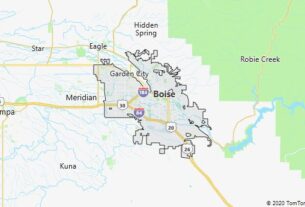Manitoba [English Maen ɪ tə ʊ bə], the easternmost of the prairie provinces of Canada, 552,371 km 2 (95,470 km without two lakes). Of the (2017) 1.34 million residents, almost 60% live in the metropolitan area of the capital Winnipeg.
The population structure is heterogeneous, numerically significant are among others. Germans and Ukrainians. Indians and Métis make up around 16% of the population. The greater part of the province, v. a. the north, belongs to the Canadian Shield; In the northeast, Manitoba borders on Hudson Bay, the south with Lakes Winnipeg, Winnipegosis and Manitoba is flat as the bottom of a former ice reservoir (Lake Agassiz), only in the west does a layer rise to 831 m above sea level. The climate is continental with strong annual temperature fluctuations and low to medium precipitation (535 mm per year).
Manitoba has a productive agriculture with the cultivation of wheat, barley, alfalfa, rapeseed and intensive cattle breeding, which, in connection with the expansion of supraregional functions, has led to a prosperous agricultural region in the southwest of the capital. Inland fishing and the timber industry in the north (production of pulp) are also important. Ore mining is v. a. operated in the north at Flin Flon and Thompson (nickel, copper, zinc ore, gold), in the southwest oil production. Only recently have large hydroelectric power plants been built in the north on the Nelson River and Saskatchewan. The industry, particularly food production, manufacturing of clothing and print products, and mechanical engineering, is concentrated in the Winnipeg metropolitan area. Churchill is located on Hudson Bay.
History: In the southern part of today’s Manitoba, various Indian tribes (Blackfoot, Sarcee, Assiniboin, Ojibwa) settled before the arrival of the Europeans, and further north on the banks of the Hudson Bay Eskimo. The first Europeans invaded the area from Hudson Bay in the early 17th century (Englishman T. Button in 1612). After the founding of the Hudson’s Bay Company (1670), trading forts were built at the mouths of the rivers, from which the company advanced south. In the 18th century, the area became the site of Anglo-French rivalry in North America. After the British conquest of Canada (1763), the 1812 (inter alia by the Scottish philanthropist Lord T. Selkirk) founded settlement on the Red River of the North to the nucleus of today’s Manitoba. It grew through the settlement of European immigrants, but also a large number of French Canadians. In 1869 the Canadian government bought the territories of the Hudson’s Bay Company, which triggered an uprising of the Métis (Indian-European mixed population) under Louis Riel (1869/70). Established in 1870 as the fifth Canadian province with an initial 36,000 km 2, Manitoba was expanded to its present size in 1881 in the west, in 1884 in the east and then in 1912 in the north.
Winnipeg
According to militarynous, Winnipeg, is the capital of the province of Manitoba, Canada, at the confluence of the Red River and Assiniboine, south of Lake Winnipeg, 793,400 residents (Census Metropolitan Area);continental location with extreme seasonal temperature fluctuations and very cold but sunny winters (on average −19.3 ° C in January). Seat of a Catholic (exemte archbishopric), an Anglican, a Greek Orthodox and a Ukrainian Catholic archbishop; University of Manitoba (founded 1877), University of Winnipeg (founded 1871), Museum of Human Rights (opened 2014) and other museums, planetarium, Royal Winnipeg Ballet, symphony orchestra, theater. Winnipeg is Manitoba’s outstanding financial and economic center, with a grain exchange and a diverse industry, including Mechanical engineering, especially transport equipment, food and beverage, wood, textile and printing industries; recent growth also in the telecommunications sector; Transport hub, international airport.
At the beginning of the 20th century, buildings in the neoclassical style were built, e. B. the government building (1913-19) with 80 m high dome. In 1973 the Canadian Mint was established. The Saint Boniface Cathedral (built in 1818) was rebuilt after a fire in 1968 with an outer skin made of cedar shingles.
The location on the eastern edge of the prairies and rivers led to the establishment of fur trading posts (1738) and fortified stations; settlement since 1812, provincial capital since 1870; after connection to the railroad in 1885 economic boom.
Charlottetown
Charlottetown [ ʃ ɑ ː lətta ʊ n], the capital and main port of the province of Prince Edward Iceland in the Gulf of Saint Lawrence, Canada, on the south coast of the island, 36 100 residents (Census Metropolitan Area: 69,300 residents); catholic bishopric; University of Prince Edward Island, museum; Food industry, wood processing, fishing, tourism; Airport.
The previous settlement was the French trading post Port-la-Joie, founded in 1720; under British rule (since 1763) re-founded at today’s place and named after Queen Charlotte (* 1744, † 1818), the wife of George III. , named; City since 1855.




